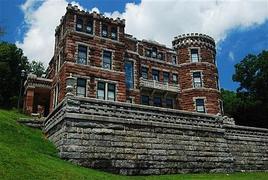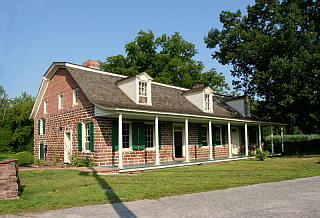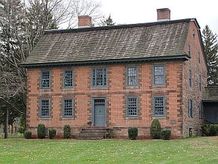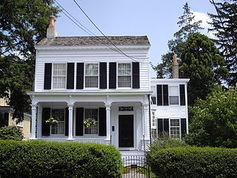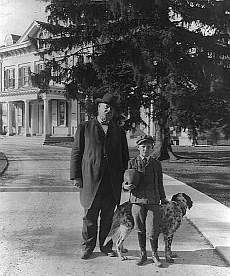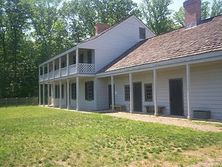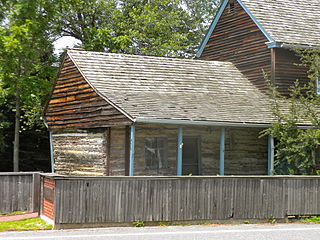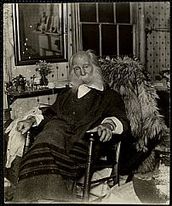|
-- Restaurants
-- Hotels -- Theaters -- Stadiums/Arenas/Teams -- Historic Homes -- Battlefields/Military -- Lighthouses -- Art Museums -- History Museums * Home
|
Historic Homes
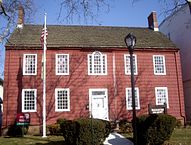 Boxwood Hall. Image: Wikimedia Commons/DMadeo GNU FDL Boxwood Hall. Image: Wikimedia Commons/DMadeo GNU FDL
Boxwood Hall Elizabeth Built about 1750, Boxwood Hall became residence of Elias Boudinot, president of College of New Jersey (now Princeton University) when school still in Elizabethtown. Boudinot became prominent Revolutionary leader, later president of Continental Congress. On way to New York for his first inauguration in April 1789, George Washington stopped at home for lunch, then escorted by Boudinot and others to Manhattan for inauguration. Boudinot sold home in 1795 to Jonathan Dayton, one of four men from New jersey to sign Declaration of Independence and later Speaker of House of Representatives and US Senator, who hosted Marquis de Lafayette at house shortly before Dayton's death in 1824. 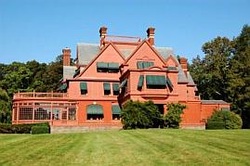
Glenmont
West Orange Home built 1880-82 in Llewellyn Park, first planned residential community in America with landscaping by Manhattan's Central Park designer Frederick Law Olmstead. Purchased by Thomas Edison as wedding gift to second wife Mina in 1886, located near site in West Orange of Edison laboratories which he relocated from Menlo Park in Middlesex County. Prominent visitors to Glenmont included Woodrow Wilson, Herbert Hoover, Helen Keller. Structure with rooms added by Edison totaled 29 rooms, seven chimneys and 23 fireplaces, shortly after purchase, Edison had home wired for electricity in 1887. Edison died in home of complications of diabetes on October 18, 1931, he and wife Mina are buried in garden behind home. Operated by National Park Service as part of Thomas Edison National Historical Park which includes Edison laboratories. * Thomas Edison National Historical Park, National Park Service * Thomas A. Edison's Historical Home, Thomas A. Edison Innovation Foundation 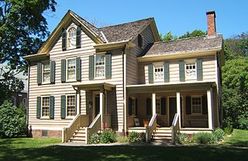 Grover Cleveland Birthplace: Image: Wikimedia Commons/Davidt8 Grover Cleveland Birthplace: Image: Wikimedia Commons/Davidt8
Grover Cleveland Birthplace Caldwell House built 1832 as pastor's residence of First Presbyterian Church of Caldwell. Grover Cleveland born in house in 1837 while his father, Reverend Richard Falley Cleveland, served 1834-41 as pastor of Church until family relocated to upstate New York when father accepted post at another church. Most of first floor rooms portray house as it was at time of Cleveland's birth in 1837. Artifacts on display include Cleveland’s baby cradle and original family portraits, as well as items from later business and political career. A group of Cleveland’s admirers purchased home in 1907, incorporated Grover Cleveland Birthplace Memorial Association, which opened house to public in 1913, subsequently transferred ownership to state. Association continues to raise funds for house preservation, coordinate tours and sponsors mobile exhibits available to schools, nursing homes, other groups. After completing second term as President, in 1897 Cleveland purchased home in Princeton, resided there with wife until his death in 1908, that house under private ownership. * Grover Cleveland Birthplace Memorial Association * Life Portrait of Grover Cleveland (video), C-SPAN 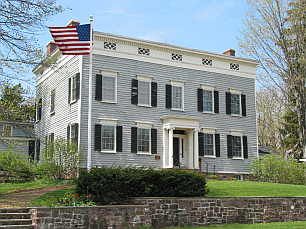 Israel Crane House: Image: Montclair Historical Society Israel Crane House: Image: Montclair Historical Society
Israel Crane House
Montclair Historical Society Montclair Built 1796 on 86-acre farm by Israel Crane (1774-1858), a descendant of founding family of Cranetown (now Montclair), and his wife Fanny Pierson (1773-1828). Israel Crane a successful merchant who constructed a turnpike that connected central and western New Jersey to eastern cities and towns. Federal-style mansion remodeled and expanded around 1840 with Greek-Revival details. Walls made of wood, with underlying layer of stone. Adjacent herb garden with gazebo. Remained in Crane family ownership until early 20th century, then sold 1920 to YWCA of Montclair-North Essex for use as its headquarters and as dormitories and social center for African American women. Montclair Historical Society saved home from demolition and relocated it to present site as part of its museum collection of historic houses, which includes Nathaniel Crane House built 1818 by Israel Crane's cousin. Tours conducted depicting early 19th century period rooms and exhibits related to local history. -- Central Jersey
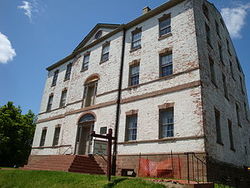 Proprietary House. Image: Wikimedia Commons Proprietary House. Image: Wikimedia Commons
Proprietary House
Perth Amboy Constructed 1762-64, became official residence of William Franklin, last Royal Governor of colony of New Jersey and illegitimate son of Benjamin Franklin, from 1774 until Franklin was arrested at house by rebel militia in 1776. During Revolution, occupied by both Patriot and British troops and also served at different times as headquarters for both American General Hugh Mercer and British General Sir William Howe. After the War, extensively damaged by fire. In 19th century, restored and re-opened as hotel named Brighton House, subsequently converted for use as retirement home and boarding house. Non-profit Proprietary House Association formed 1966 to preserve and restore building, persuaded state to purchase property in 1967. State leased house to Association in 1974, first opened for public visits during 1976 bicentennial celebration. Tours held most Wednesdays and last Sunday of month, others by special reservation, also available for rental for private events. 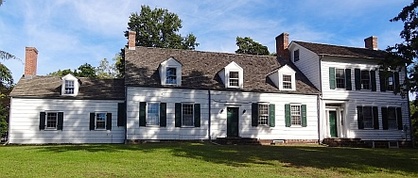 Abraham Staats House. Image: Wikimedia Commons/By Zeete CC BY-SA 3.0 Abraham Staats House. Image: Wikimedia Commons/By Zeete CC BY-SA 3.0
Abraham Staats House
South Bound Brook Built around 1740 near Raritan River during Dutch settlement of Raritan Valley. At time of Revolution, owned by Abraham Staats, a farmer and surveyor who was active in movement for independence, targeted by British for hanging, possibly for role in spy network. Property strategic site during Revolution, house served as headquarters for General Baron Von Steuben from March to June 1779 while Continental Army encamped nearby, house also visited by George Washington, other generals and French minister M. Girard. Acquired by Borough of South Bound Brook in 1999 with grant assistance from Somerset County. Open for free tours on 2nd Saturday of each month from 10 am to Noon, closed during July and August. 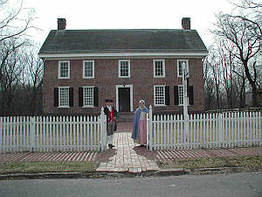 Wallace House.
Image: State of New Jersey Wallace House.
Image: State of New Jersey
Wallace House Somerville Completed in 1776 as Hope Farm for John Wallace, a successful Philadelphia textile merchant. Shortly after house constructed, General Washington leased it as his headquarters during the Middlebrook Winter Encampment from December 1778, to June 1779, with Continental Army encamped some three miles away. During part of stay, Washington joined by wife Martha, guests entertained at house included Alexander Hamilton, Benedict Arnold, Nathaniel Greene and Baron von Steuben. Considered one of most original examples of Georgian architecture in New Jersey. Revolutionary Memorial Society bought the house in 1896, and gave it to state of New Jersey in 1947. Old Dutch Parsonage Somerville Built in 1751, first occupied by Reverend John Frelinghuysen, son of Theodorus Frelinghuysen, a German who had lived for a short time in Holland before emigrating in 1720. John Frelinghuysen served three congregations of the Dutch Reform church in upper Raritan Valley. Room in the house served as a Dutch Reformed religious seminary, second resident of the Parsonage, Reverend Jacob Hardenbergh, founded in 1766 Queens College, later to become Rutgers University, while residing in the house and became College's first president. House relocated in 1913 from original site in Somerville to location adjacent to Wallace House, acquired 1947 and operated by state of New Jersey in conjunction with Wallace House. 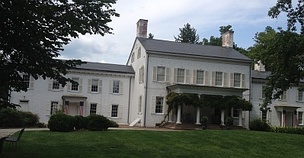 Morven. Image: NewJerseyAlmanac.com Morven. Image: NewJerseyAlmanac.com
Morven
Princeton Original home built in 1750s by Richard Stockton on 150 acres of land first purchased as 5,500-acre tract in 1701 by his grandfather from William Penn. Stockton a Revolutionary leader, tied in first provincial assembly vote with William Livingston for state governor, subsequently declined appointment as chief justice, captured and imprisoned by British during War, released after petition in his behalf by Continental Congress. Stockton's wife Annis Boudinot Stockton named "Morven" after a mythical Gaelic kingdom in Ireland, she became noted poet called "Muse of Morven" by George Washington, who was entertained in house. House remained owned by Stockton family into 20th century, rented in 1930s by Robert Wood Johnson II, chairman of Johnson & Johnson. In 1944, New Jersey Governor Walter Edge purchased Morven from Stockton family, subject to condition that Morven would be given to the state of New Jersey within two years of Edge's death, but transferred ownership to the state during 1954, before he died in 1956. Home became official governor's residence for Governors Meyner, Hughes, Cahill and Byrne from 1955 to January 1982. In 1982, upon inauguration of Governor Kean, Governor's Mansion re-designated to nearby Drumthwacket, a larger mansion, and Morven restored and adapted as a museum under state ownership and operated by nonprofit Morven Foundation. Open for public visits and for rental for weddings and other private events. 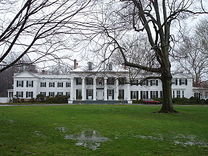 Drumthwacket. Image: Wikimedia Commons/KForce CC by SA-3.0 Drumthwacket. Image: Wikimedia Commons/KForce CC by SA-3.0
Drumthwacket
Princeton Official residence of Governor of New Jersey since 1982, but primarily used by Governor Christie for meetings, special events. Public tours on most Wednesdays by prior registration, also open to public during winter holiday season, annual Easter egg hunt. Home built in 1835 by Charles Smith Olden, elected Governor 1859, served 1860-63 during first years of Civil War, subsequently judge on Court of Errors and Appeals 1868-73. Olden family had owned land almost continuously since 1696. House near former Governor's official residence at Morven, now a museum, and state park at site of Battle of Princeton. Listed on National Register of Historic Places. 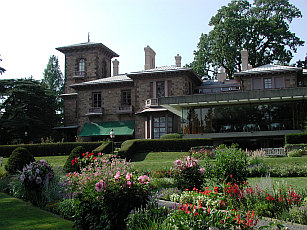 Prospect House. Image: Princeton University Prospect House. Image: Princeton University
Prospect House
Princeton Originally a model farm, Prospect House purchased in 1824 by John Potter, a wealthy merchant from South Carolina. His son Thomas F. Potter demolished original Georgian farmhouse and replaced it in 1851 with present Italianate villa with extensive garden designed by prominent architect John Notman. Acquired in 1878 by Robert and Alexander Stuart of New York, who donated house and 35-acre property to College of New Jersey (now Princeton University), for use as residence for school's presidents, including Woodrow Wilson who lived in house when president of University between 1902 and 1910. In 1968, residence for presidents relocated to Walter Lowrie House off main campus, with Prospect converted for use as faculty club for dining and receptions. Available for rental for wedding receptions and other private affairs.
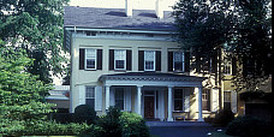 Grover Cleveland House (Westland) Image: National Park Service Grover Cleveland House (Westland) Image: National Park Service
Grover Cleveland House (Westland) Princeton Georgian Revival house built 1854 by Commodore Robert F. Stockton, head of Joint Companies which owned, operated Delaware & Raritan Canal and Camden & Amboy Railroad. After completing his second presidential term ended in 1897, Grover Cleveland and his wife purchased house, named it "Westland" in appreciation of role in selecting house of friend, Princeton Professor Andrew Fleming West, later named first dean of new Princeton Graduate College and also closely aligned with Cleveland after Cleveland named to Princeton board of trustees, with West and Cleveland allied in opposing Princeton President Woodrow Wilson's plan to locate graduate school on undergraduate campus rather than on its own separate site. Cleveland home became gathering place for students, especially after sports or debating victories, with student parades held every March 18 to celebrate Cleveland's birthday. Cleveland died in home on June 24, 1908 at age of 71, buried with wife in Princeton Cemetery. After his death, main tower of Graduate College named as memorial to Cleveland. Designated as National Historic Landmark, but home remains in private ownership, no public visits.
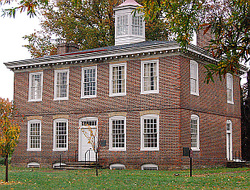 William Trent House. Image: State of NJ William Trent House. Image: State of NJ
William Trent House
Trenton Brick home built around 1719 at Falls of the Delaware River by wealthy merchant William Trent, who in following year incorporated and named town of Trenton. Property included entrance down to ferry landing, grist and saw mills along Assunpink Creek and several outbuildings. House leased in 1742 to Lewis Morris, first Governor of separate colony of New Jersey, house then called “Bloomsbury Court,” used as his official residence until 1746. During Revolution, house occupied by Hessian forces. House confiscated by new state government from then Loyalist owner of property, acquired by Colonel John Cox, wealthy Philadelphia patriot and Deputy Quartermaster General of Continental Army, who used grounds as supply depot for Washington’s army. Purchased in 1835 by Philemon Dickerson, Jacksonian Democrat elected Governor in next year and used house as Official Residence. Also served as Official Residence of Governor in 1854 when purchased by Democratic Governor Rodman McCamley Price. Last private owner of house, Edward A. Stokes, donated building to City of Trenton in 1929 with condition that it be restored to its appearance during William Trent era and be used as a library, art gallery or museum. After extensive restoration, opened as a museum in 1939, owned by City of Trenton and operated by nonprofit Trent House Association. -- South Jersey
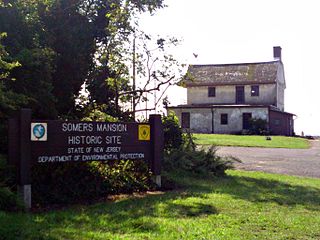 Somers Mansion. Image: Wikimedia Commons/deadhenry CC by SA 3.0 Somers Mansion. Image: Wikimedia Commons/deadhenry CC by SA 3.0
Somers Mansion
Somers Point Oldest surviving home in Atlantic County, first noted in minutes of 1726 meeting at home of Great Egg/Cape May Society of Friends. Three-story home overlooking Great Egg Harbor Bay built of brick in Flemish Bond Pattern. Land on which home built originally part of 3,000-acre parcel purchased 1695 by John Somers, whose great grandson Richard Somers was a US Navy officer killed at age 25 in 1804 along with 12 crew of the small ketch Intrepid in explosion on ship during assault on Barbary pirates in harbor at Tripoli, Libya. Ongoing efforts to seek return of remains of Somers and crew from Libya for reburial with other family graves in Somers Point. Home overlooks Great Egg Harbor Bay. In 1937, Somers descendants deeded home to create permanent memorial of Somers family, transferred 1941 to state of New Jersey. Open to public, contains 18th-century furnishings, textile collection includes locally fashioned quilts, coverlets and samplers. * Master Commandant Richard Somers, Somers Point Historical Society * Bringing Richard Somers Home, Project Intrepid * The Intrepid Project
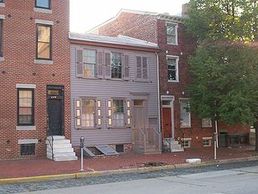 Walt Whitman House. Image: Wikimedia Commons Walt Whitman House. Image: Wikimedia Commons
Walt Whitman House
Camden House in which poet Walt Whitman lived from purchasing it in 1884 until his death in 1892. Whitman relocated in 1873 to Camden from Washington, DC, first living with brother and sister-in-law in their home. While living in the home, despite being in poor health, Whitman completed several poems, as well as revising last of several editions of his poetry collection, Leaves of Grass, but only earned an estimated $1,300 and was largely dependent on donations from admirers. |

